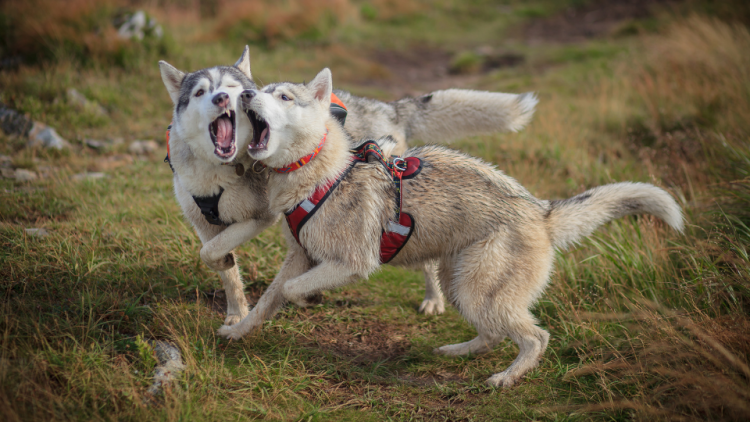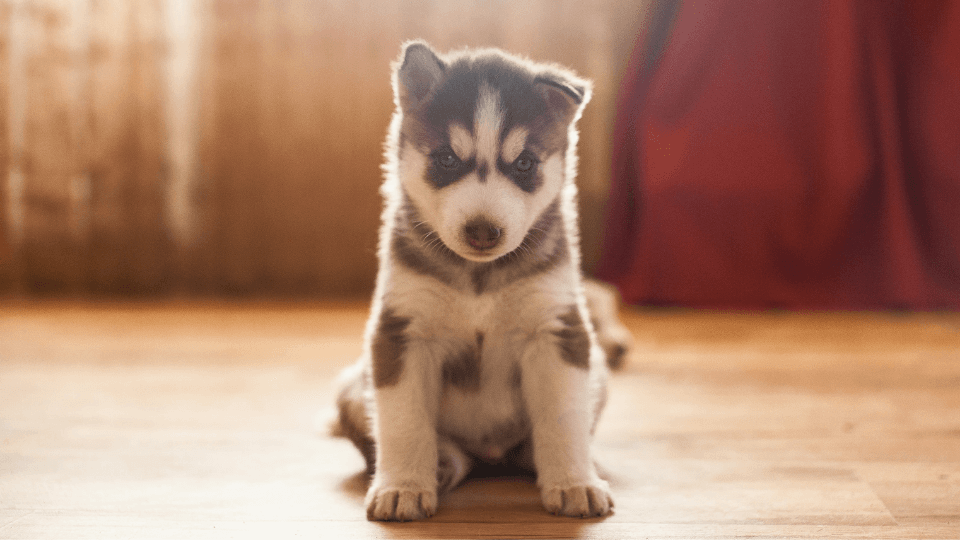Siberian Huskies are well-known as sled dogs. While many lay people know them as “huskies,” the term, “Siberian” is preferred by those most familiar with the breed. They are known to be graceful, relatively clean dogs that can make excellent family companions with appropriate training. Siberians are known for their characteristic almond eyes that come in either brown, blue, or one of each color.
If you have or are considering adding a Siberian to your family, you may be wondering how big these dogs might get. You can use our Siberian Husky growth chart to track your pup’s development.
Here's everything you need to know about Siberian Husky growth:
- Siberian Husky Growth & Weight Chart
- At what age is a Siberian Husky fully grown?
- How big should a 6-month-old Siberian Husky be?
- How much bigger will my Siberian Husky get?
- How big is a full-grown Siberian Husky?
- How do I make sure my Siberian Husky is healthy?
- Key Takeaways
Siberian Husky Growth & Weight Chart
| Age | Male Weight | Female Weight |
|---|---|---|
| 1 month old | 3 - 5 lb | 2 - 6 lb |
| 2 months old | 10 - 15 lb | 5 - 10 lb |
| 3 months old | 20 - 30 lb | 15 - 20 lb |
| 4 months old | 27 - 32 lb | 20 - 25 lb |
| 5 months old | 34 - 39 lb | 23 - 27 lb |
| 6 months old | 30 - 40 lb | 25 - 33 lb |
| 7 months old | 35 - 45 lb | 27 - 35 lb |
| 8 months old | 40 - 50 lb | 28 - 37 lb |
| 9 months old | 40 - 50 lb | 29 - 39 lb |
| 10 months old | 45 - 55 lb | 30 - 42 lb |
| 11 months old | 45 - 55 lb | 30 - 45 lb |
| 12 months old | 45 - 60 lb | 35 - 50 lb |
| 2 years old | 45 - 60 lb | 35 - 50 lb |
Most Siberian Huskies weigh 60 pounds or less and classify as a medium-sized dog breed. Siberian Huskies weigh less than other sledding dogs, such as the Alaskan Malamute, because they were developed to work in teams who pulled lighter loads quickly across the tundra. As a result,.
Note: The Siberian Husky weight chart numbers contains estimates for growth, so don't worry if your puppy is slightly behind or ahead of these figures. Consult with your veterinarian if you have any questions or concerns about your pup’s growth.
At what age is a Siberian Husky fully grown?
Siberian Huskies are considered full-grown around their first birthday. At a year old, most Siberians will be at their full height. However, according to the American Kennel Club, many dogs of this breed will need a few more months to finish filling out their chest. Your Siberian Husky puppy should be fully grown by 15 months old. Make sure to consult with your veterinarian to ensure that your Siberian is at a healthy weight for their body size.
How big should a 6-month-old Siberian Husky be?
At six months old, a male Siberian Husky will weigh around 30 to 40 pounds. Their female counterpart will weigh slightly less, approximately 25 to 33 pounds.
Pro Tip: Don’t miss our new puppy checklist for tips on preventive pet care, vaccination schedules, microchipping your pet, and more.

How much bigger will my Siberian Husky get?
There are a few ways to estimate how much bigger your Siberian Husky will get:
- Age. If your puppy is less than a year old, they definitely still have growing left to do! Most Siberian Husky puppies will need at least 15 months to finish growing and filling out their chests.
- Genetics. If you purchased your Siberian Husky from a breeder, you could reach out to them about your puppy’s estimated adult weight and height. Based on your Siberian’s parents and their past litters, your breeder should be able to provide you with a more precise estimate of how big your puppy will grow.
- Paw size. Lastly, you take a look at your puppy’s paws. While not a perfect science, paws that look oversized next to your puppy’s body can indicate that your puppy is still growing and filling out.
How big is a full-grown Siberian Husky?
According to the American Kennel Club Official Siberian Husky Breed Standards, a male Siberian Husky should stand between 21 and 23.5 inches tall and weigh between 45 and 60 pounds. Comparatively, a female Siberian Husky should weigh between 35 and 50 pounds and stand between 20 and 22 inches tall.
Adult Siberians should appear well-balanced and be nimble. Siberians have a characteristic gait that is both graceful and quick, which dates back to their breed’s original job as a sled dog.
Fun Fact: Initially bred in northeastern Asia, Siberian Huskies were developed as sled dogs and companions. The most famous Siberian Husky, Balto, is revered for delivering an antitoxin serum to the small town of Nome, Alaska, where an epidemic of diphtheria was occurring in 1925. The dog sled relay across the U.S. Territory took about 150 dogs nearly 5.5 days to complete in difficult terrain and horrendous conditions, but saved countless lives as a result. To this day, New York City has a statue of Balto in Central Park to honor him and the other Siberian Huskies that delivered the serum.

How do I make sure my Siberian Husky is healthy?
Prevention is a crucial part of keeping your Siberian Husky healthy and happy. Routine veterinary care and a healthy lifestyle can help to prevent and minimize future health problems in your dog. This is especially important because many purebred dogs are at an increased risk of genetic health problems. Siberians are particularly prone to cataracts, cancer, glaucoma, and zinc-responsive-dermatosis.
Zinc-responsive-dermatosis occurs in Siberian Huskies more frequently than most dog breeds. Typically, Siberians with this condition consume enough zinc in their diets but cannot absorb the zinc properly. A zinc deficiency can lead to itchy, dry coats, stunted growth, diarrhea, and increased infections. Zinc-responsive-dermatosis is usually treated with a change in diet and added zinc supplementation.
Pro Tip: New pet parents can get reimbursed for up to 90% of veterinary bills by enrolling in a pet insurance plan. Compare Siberian Husky health insurance options today to get peace of mind knowing that your Siberian Husky has access to gold-standard veterinary care for life.
Siberians, like many purebred dogs, are also at a heightened risk of cancer. A cancer diagnosis is the last thing any pet parent wants to hear. Fortunately, new treatments and technologies are improving the prognosis for some types of cancer. However, these treatments can be costly. For example, lymphoma, a common canine cancer, can easily cost up to $10,000 to treat.
Siberian Husky Veterinary Costs
When the worst happens to our beloved pets, the last thing on our minds should be how to cover the costs of vital veterinary treatments. This is where pet insurance comes in. Pet insurance works by reimbursing you for up to 90% of out-of-pocket veterinary costs, allowing you to take care of your dog when the worst happens. Like humans, dogs are living longer lives and will require excellent veterinary care to maintain a happy and healthy quality of life. Pet insurance makes this possible by providing you with a financial safety net should your Siberian have an accident, injury, or develop an illness, such as cancer.
In addition to this, many pet insurance plans have the option for wellness add-ons, which reimburse you for the cost of regular veterinary care, such as annual exams and routine blood work. Routine veterinary care allows your veterinarian to screen your Siberian Husky for health problems so that any health issues that arise can be treated quickly and early on when the prognosis is typically better.
Your Siberian Husky is a beloved member of the family who deserves top-notch veterinary care. Don’t wait for the worst to happen to your pup. Sign up for a pet insurance plan today and rest easy knowing that your puppy is covered should anything happen to them.
Key Takeaways
- Male Siberian Huskies weigh between 45 and 60 pounds, while female Siberian Huskies weigh between 35 and 50 pounds.
- Our Siberian Husky growth chart can help you to estimate and track your puppy’s growth through its developmental stages.
- Siberian Husky hereditary conditions are common, and the breed is particularly prone to cancer.
- The best way to help your Siberian Husky pup live a happy and healthy life is with preventive care and routine vet visits. Enrolling in a pet insurance plan can help you to save money on covered costs.
